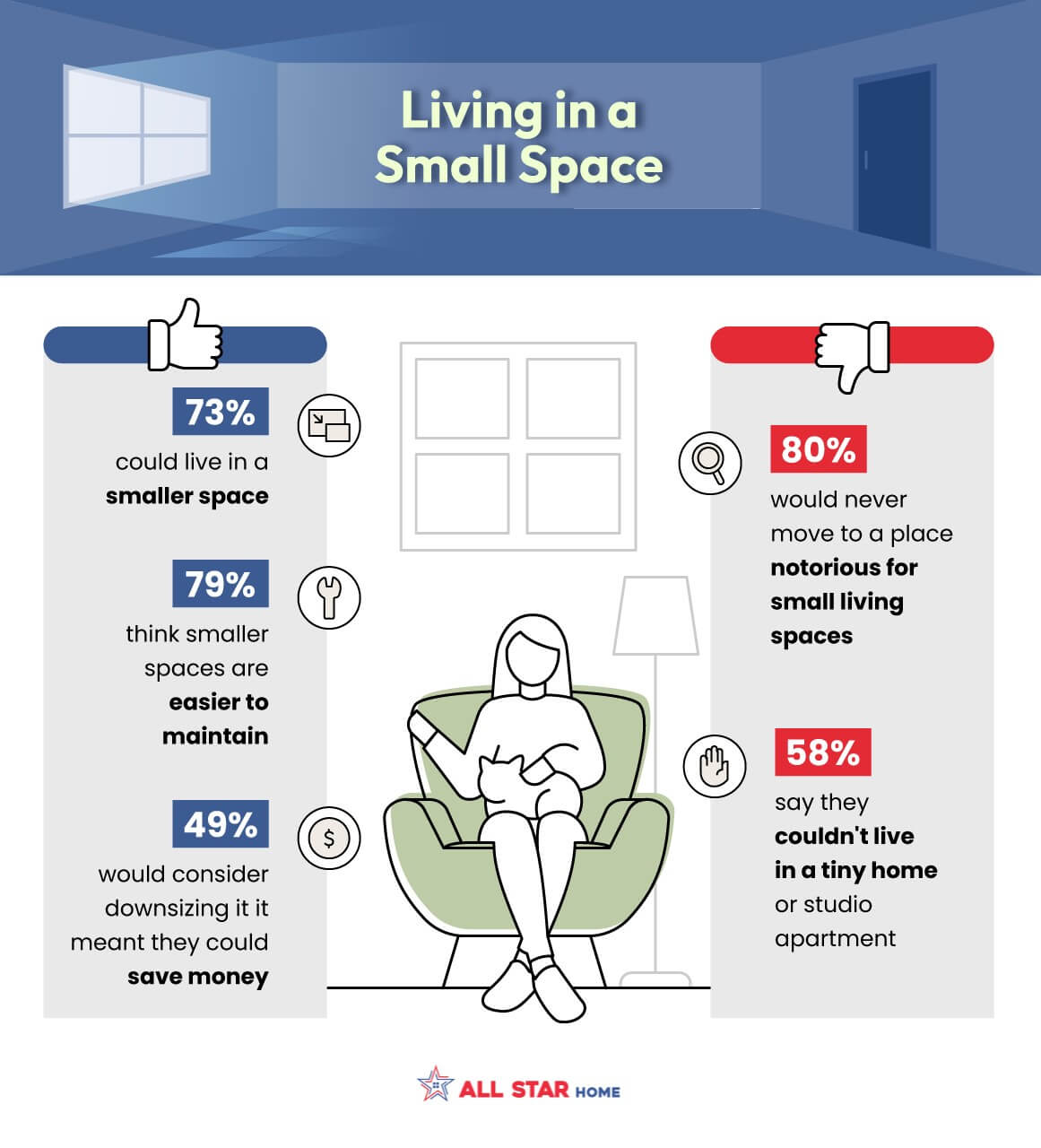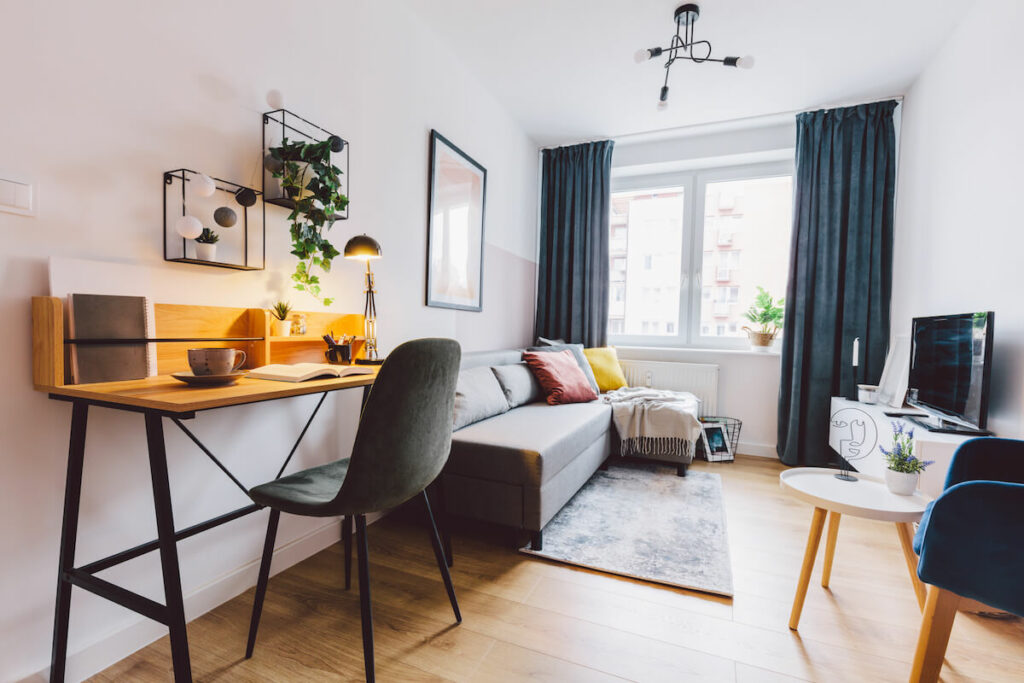When it comes to city living, space is generally limited. From small studios in New York City to micro apartments in Seattle, it’s widely known city dwellers often have to make do with less. But what cities have the smallest spaces? And how do homeowners feel about living in cramped quarters?
At All Star Home, we analyzed U.S. Census Bureau data to determine which U.S. cities have the smallest living spaces in the country’s top 15 metropolitan areas. We also surveyed American homeowners to see how they feel about the size of their living space.
How Americans Feel About Their Living Space

According to our survey of 800 American homeowners, the average living space is 1,841 square feet, nearly triple the size of the average living space (per person) in San Francisco! Despite that, more than half (51%) of homeowners want more space. The top reasons for needing more space include having accumulated more stuff, a pet, and working from home. People also reported that the space was never big enough to begin with or they have outgrown the space.
A key reason for needing more space is belongings. More than 2 in 5 (43%) feel like all of their belongings make it hard to live in their space, and 36% feel the biggest struggle in their current home is not having enough storage space.
That makes sense when the top reason for needing a bigger home is because people have accumulated more stuff (59%). Other main reasons include a pet (37%) and working from home (30%). People also reported that the space was never big enough to begin with (31%) or they have outgrown the space (25%).
The most desired living space upgrade includes a bigger kitchen, more storage options, bigger bedrooms and bathrooms, and a garage.
1 in 3 American Homeowners Don’t Think They Will Ever Be Able to Afford More Space

Living in tight quarters is a challenge for many Americans, but for one reason or another, they haven’t been able to upgrade their space. Price is the main reason. Even though the majority of Americans want more living space, 63% say they can’t afford it right now. Furthermore, 1 in 3 believe they will never be able to afford more space.
The top reason homeowners aren’t in search of a bigger living space is cost. People said the price of moving or building is just too expensive right now. Others blamed high home prices and interest rates. People also listed the hassle of moving as another reason they haven’t pursued getting more living space.
Americans Would be Willing to Live in Small Spaces… For a Price

While American homeowners aren’t entirely happy with the size of their living space, there are some positives. 79% think smaller living spaces are easier to maintain, and nearly 3 in 4 think they could live in a smaller living space, especially if it meant it could save them money! 49% would consider downsizing if it meant they could keep more cash in their pocket.
But as for those small living spaces in the country’s major cities, most aren’t having it. 4 out of 5 said they would never move to a place that is notorious for small living and 58% said they couldn’t live in a tiny home or studio apartment.
op 15 U.S. Cities with the Smallest Living Spaces

While many think New York City is notorious for tiny living, The Big Apple wasn’t the smallest in our ranking analysis. The top three cities were in California with San Francisco being the smallest at 667 square feet per person.
While residents of California’s Golden City in the North have had to embrace innovative housing solutions and smaller spaces, so have residents in the southern part of the state. Located just outside of Los Angeles, Riverside came in second at 673 square feet per person. Living space in L.A. is slightly larger at 675 square feet.
Back on the East Coast, New York City has the fourth smallest living space in our ranking with 720 square feet per person. Miami (750 square feet) and Boston (785 square feet) have slightly larger living spaces but are still less than 800 square feet per person.
Living spaces in Chicago and Detroit boast 800 square feet per person. Properties in Philadelphia have 809 square feet per person. Seattle rounds out the top 10 U.S. cities with the smallest living spaces with 825 square feet per person.
There’s a little more space to spread out in these last five cities. Properties in Phoenix have 833 square feet per person. In Dallas and Houston, residents get 850 square feet per person and in the nation’s capital, properties have 900 square feet per person. The largest living space is in Atlanta, with 1,000 square feet per person.
Whether you’re living in your dream home or still dreaming about the day you can spread out in a bigger space, a home is what you make of it. We hope you can make the most out of whatever space you currently have, and remember a home is more than just the square footage. It’s about the people you surround yourself within those walls.
Methodology
In August 2023, we analyzed data from the U.S. Census Bureau’s 2021 American Housing Survey. We used the owner “tenure filter” to find the median square footage for properties in the top 15 metropolitan areas and ranked them from smallest to largest.
In August 2023, we surveyed 801 American homeowners about the size of their living spaces and what they would want in a larger space. 83% of respondents lived in single-family homes, 4% in townhomes, 3% in multi-family homes, 3% in condos, 3% in mobile homes, 2% in apartments, 1% in tiny homes, and 1% in co-ops. Respondents were 50% male, 49% female, and 1% non-binary. Respondents ranged in age from 19 to 76 with an average age of 47 years old.
For media inquiries, please contact media@digitalthirdcoast.net.
Fair Use
When using this data and research, please attribute by linking to this study and citing allstarhome.com.











